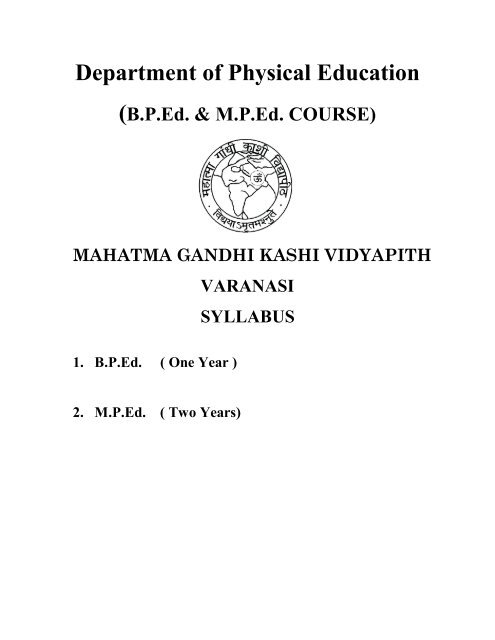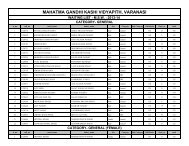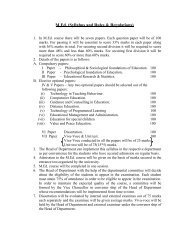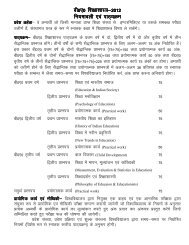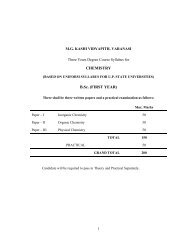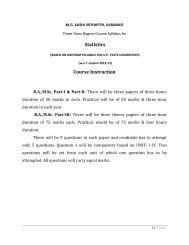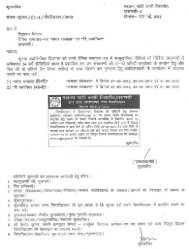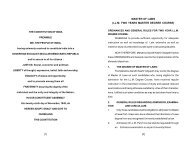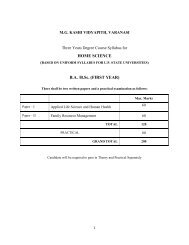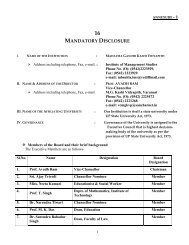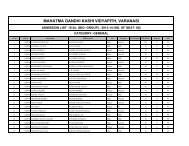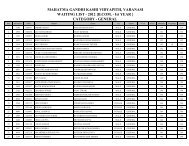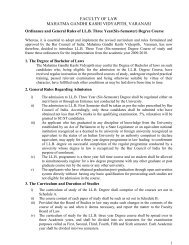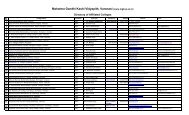Department of Physical Education - Mahatma Gandhi Kashi ...
Department of Physical Education - Mahatma Gandhi Kashi ...
Department of Physical Education - Mahatma Gandhi Kashi ...
You also want an ePaper? Increase the reach of your titles
YUMPU automatically turns print PDFs into web optimized ePapers that Google loves.
<strong>Department</strong> <strong>of</strong> <strong>Physical</strong> <strong>Education</strong>(B.P.Ed. & M.P.Ed. COURSE)MAHATMA GANDHI KASHI VIDYAPITHVARANASISYLLABUS1. B.P.Ed. ( One Year )2. M.P.Ed. ( Two Years)
B.P.Ed. SYLLABUS“kkjhfjd f”k{kk ds fl)kUr ,oa f”k{kk euksfoKku¼ Principles <strong>of</strong> <strong>Physical</strong> <strong>Education</strong> And <strong>Education</strong>al Phychology½;wfuV & 1izFke iz”u i=1- ifjp; % fl)kUr dk vFkZ & fQthdy ,tqds”ku fla)kUrksa ds lzksr rFkk lEcfU/kr fo’k; A2- f”k{kk rFkk “kkjhfjd f”k{kk dh ifjHkk’kkA3- f”k{kk rFkk “kkjhfjd f”k{kk dk y{; ,oa mís”;&”kkjhfjd laLd`fr]”kkjhfjd izf”k{k.kA;wfuV& 21- ØhM+k ,oa ØhM+k dh F;ksjhA2- “kkjhfjd f”k{kk ds ck;ksykftdy vk/kkj]oa”kkuqxr y{k.k]ely Vksu( ,FkysfVd ân;]vuflØkukbTMMsoyiesaV]jsflizksdy buosZ”ku]okbVy dSisflVh]fd”kksjkoLFkk esa ;qodksa ,oa ;q<strong>of</strong>r;ksa ds vUrj]”ksYMuo Øse”kj ds vuqlkj lkseSVks Vkbi oxhZdj.k]O;k;ke ,d ck;ksykftdy vfuok;Zrk] fodkl]lajpuk] dk;ZA3- lekt”kkL=h; vk/kkj & O;fDr ,oa lekt] ekU;rk ,oa ljkguk dh bPNk] lkekftd lewg dkegRo & ifjokj] leqnk;] Ldwy]jkT;]jk’Vª]yksdra=h; fpUru]usrk o vuq;k;h]O;fDr &O;fDr ds izfrvknj]lekurk]jk’Vªh; ,drkA;wfuV &3f”k{kk euksfokKku ¼<strong>Education</strong>al Psychology½1- ifjp; &euksfoKku D;k gS\bldk {ks= ,oa vU; foKkuksa ls lEcU/kA2- ewy y{k.k & vuqokaf”kd rFkk i;kZoj.kh;&euksfoKku O;fDrRo ds izdkjA3- O;fDr vkSj mldh mRifRrA4- U;wjks & lsaljh flLVe&lsljh eksVj vkfnA5- o`f} lkeF;Z&vkbZ-D;w-,oa ih-D;w&O;fDrxr vUrj &o`f} y?kqÙkk]eksjksu~l&bEcslkbyl ,oa bfM;V~lA6- ewy iz<strong>of</strong>Rr ,oa laosxA;wfuV &41- vf/kxe & vf/kxe ds fl)kUrA¼ i ½ vuqdj.k¼ii½ d.Mh”k.M jSLikSalA¼iii½ Vªk;y o ,jjA¼iv½ bulkbV2- vf/kxe dh f<strong>of</strong>/k¼i½ jsMhusl¼ii½ vH;kl¼iii½ izHkko¼iv½ Øfedrk¼v½ vkReh;rk3- vf/kxe dk LFkkukUrj.k & “kkjhfjd dq”kyrkvksa ds lanHkZ esaA4- fodkl dh voLFkk;saA5- vfHkizsj.kk& vFkZ]vko”;drk ,oa izdkjA6- euksfoKku ds O;kogkfjd lq>koA
“kkjhfjd f”k{kk esa laxBu]iz”kklu]i;Zos{k.k ,oa i)fr;k¡¼ Organisation,Administration,Supervision& Method in <strong>Physical</strong> <strong>Education</strong> ½;wfuV&1f}rh; iz”u i=1- Hkwfedk & lkekU; f”k{kk ls “kkjhfjd f”k{kk dk lEcU/k] laxBu rFkk iz”kklu dk rkRi;Z&laxBu dkegRoA laxBu ds funs”kd fl)kUrA2- LokLF; rFkk “kkjhfjd f”k{kk dh ;kstuk;sa & fo|ky;] egkfo|ky;] fo”<strong>of</strong>o|ky;] tuin jkT;A3- “kkjhfjd f”k{kk dh lqfo/kk;sa rFkk ekin.MA[ksy ds eSnku & oká ,oa vkUrfjd f”k{k.k laLFkkvksa ds fy, ekdu [ksy ds eSnkuksa dk foU;kl¼Lay out½ ,FkysfVd iFk dh ns[kHkky rFkk vuqj{k.k HkhM+HkkM+ ;qDr “kgjksa ds fo|ky;ksa esa [ksy dseSnku dk vHkko dh leL;k mldk lek/kku& lkoZtfud ØhM+k LFkyAftEuSft;e& f”k{k.k laLFkkvksa ds fy, ekud fu/kkZj.k ,oa ns[kHkkyArj.krky& f”k{k.k laLFkkvksa ds fy, ekud rj.krky ds izdkj ¼Hkjuk [kkyh djus okysa fujUrj rFkkvuojr forj.k izdkj rky dk fuekZ.k ns[kHkky ,oa vuqj{k.k] rky ds fu;eA½lktlTtk&f”k{k.k laLFkkvksa ds fy, U;wure vko”;drk]lktlTtk dh [kjhn ¼uhfr ,ao izfØ;k½lkekuksa dh ns[kHkky ¼lkekU; ,oa fo”ks’kA½dk;ZdrkZ ds usr`Ro & izf”kf{kr usrk dh vko”;drk “kkjhfjd f”k{k.k izf”k{k.k dh ;ksX;rk;sa] v/;kiudk;ZHkkj rFkk f”k{k.k &Nk= vuqikr dh “kkjhfjd f”k{k.k ls lEcU/k & f”k{k.k] iz/kkukpk;Z] fujh{kd]d{kk/;kid] vfHkHkkod rFkk leqnk; Nk=]usr`RoA4- dk;ZØe fu:i.k & ikB~;Øe dh vko”;drk ,oa egRo ikB~;Øeksa dh rS;kjh rFkk fodklA dk;ZØeksa dsizdkj] dk;ZØe fu/kkZj.k dks izHkkfor djus okys rRo]lqn`
;wfuV &41- Hkwfedk ¼izf<strong>of</strong>/k;k¡½ & izf<strong>of</strong>/k;ksa dk vFkZ ,oa egRo]izf<strong>of</strong>/k;ksa dks izHkkfor djus okys dkjdA2- izLrqr djus dh rduhd&¼v½ O;fDrxr rS;kjh & rduhdh rS;kjhoLrq foU;kl ¼Organising Subject Matter½f”k{k.k lgk;d oLrq,a ¼Teaching Aids½d{kk izcU/k ¼Class Management½¼c½ izLrqr djus ds lksiku&vfHk:fp tkxj.k ¼Orientation½]vUos’k.k]lq/kkj ,oa iqujko`fRr] ppkZ ,oa ewY;kaduA¼l½ fØ;kdykiksa ds f”k{k.k dh f<strong>of</strong>HkUu izf<strong>of</strong>/k;k¡] vkns”kkRed f<strong>of</strong>/k] izn”kZu f<strong>of</strong>/k] bPNkuqlkj f<strong>of</strong>/k] fuf”prO;k;ke f<strong>of</strong>/k] va”k ,oa iw.kZf<strong>of</strong>/kA¼n½ vkns”ku ¼Commanding½3- dk;ZØeksa dk pquko ,d f”k{k.k &¼d½ LFkkuh; O;k;ke esa lfgr vkSipkfjd fØ;kdykiA¼[k½ fteuSfLVDlA¼x½ rkyc) dk;ZA¼?k½ eq[; [ksyA¼M+½ NksVs [ksyA¼p½ VªSd ,oa eSnkuA¼N½ j{kkRed dyk;saA¼t½ ,DoSfVDlA
dk;Zogu ,oa izf”k{k.k ds fl)kUr¼Principles <strong>of</strong> <strong>of</strong>fciating & Coaching½;wfuV &1r`rh; iz”u &i=fuUefyf[kr [ksyksa ds dk;Zogu izf”k{k.k ds fl)kUr ,oa iz;ksxA QqVcky] gkdh] ckyhoky] ckLdsVcky] fØdsV]dcM~Mh] [kks&[kks] dq”rh] rSjkdh] ,FkysfVDl] Vscqy&Vsful] ftEuSfLVd] cSMfeaVu] gS.Mcky ,oa ;ksxAfuEufyf[kr “kh’kZdksa ds vUrxZr izR;sd [ksy dk v/;;u gksxk&¼d½ lE<strong>of</strong>U/kr [ksy dk bfrgkl ,oa fodkl]¼[k½ [ksy ds eSnku dk ekiu ,oa fpUgkadu]¼x½ ekud [ksy midj.k]¼?k½ fu;e ,oa mudh O;k[;k];wfuV &21- f<strong>of</strong>HkUu [ksyksa ds vf/kdkfj;ksa ds drZO; & dk;Zogu iz.kyh] LFkku ladsr vkfnA2- izf”k{k.k dk n”kZu & izf”k{kd dsa O;fDrxr xq.k ,oa vgZrk;saA3- xked {kerk ds ?kVd &xfr] ”kfDr] lgu”khyrk] yksp] rkyesy {kerkA4- izf”k{kr Hkkj ,oa fjdojhA;wfuV &3izf”k{k.k ds fl)kUr&1- vk/;kiu] izf”k{k.k ,oa dksfpax ds oSKkfud fl)kUr] xq:Rokd’kZ.k cy &U;wVu dk fu;e] mÙksyd] le:irk]xfr osx ¼lgh Lo:i ,oa “ksyh ds lnHkZ esa½ xfr ,oa lVhdrkA2- izf”k{k.k esa ihjhvksaMhts”kuA;wfuV &4¼d½ vuwdwyu O;k;keA¼[k½ Hkkj izf”k{k.kA¼x½ vk/kkjHkwr dkS”ky dk v/;kiu dkS”ky dk vk;keA¼?k½ yhM+&vi xseA¼M+½ LFkku ewyd xseA¼p½ uhfr &vkØe.k ,oa cpkoA
“kjhj jpuk “kjhj fØ;k ,oa O;k;ke eas fØ;k foKkuAnatomy, Physiology and Exercise Physiology;wfuV & 1prqFkZ iz”u & i=1- thoksa dk Lo:iA2- dksf”kdk ,oa blds vax &dksf”kdk foHkktu] thou dk dks”kdh; vk/kkjA3- vkuqokaf”kdrkA4- fodkl euq’; dk vius dh fodkl ewyd
xfrcy foKku] LokLF; f”k{kk ,oa [ksydwn pksV dh ns[kHkkyKineseology,Health <strong>Education</strong> and Care <strong>of</strong> Athletic Injuries;wfuV &1iape iz”ku & i=1- xfrcy foKku ifjHkk’kk]vFkZ ,oa {ks=A2- “kkjhfjd f”k{kk ,oa [ksydwn esa xfrcy foKku dk dk;ZA3- “kjhj esa laf/k;ksa dh lajpkuk ,oa muds dk;Za4- ekalisf”k;ksa dk mn~Hko vUrHksnu ,oa dk;ZA5- “kjhj mÙkksyd & mÙkksyd dk;Z] izFke Js.kh mRrksyd] f}rh; Js.kh mRrksyd] r`rh; Js.kh mRrksyd] f[kapkods dks.k dk izHkko] izfrjks/k ds dks.k dk izHkkoA6- fuEufyf[kr ekalisf”k;ksa ds fo”ks’k lanHkZ esa “kjhj ds f<strong>of</strong>HkUu vo;oksa ds fodkl gsrq O;k;ke dk;ZØe&¼i½ lhus dh ekalisf”k;k¡A¼ii½ isV dh ekalisf”k;k¡A¼iii½ ihB dh ekalisf”k;k¡A¼iv½ xnZu dh ekalisf”k;k¡A¼v½ m)oZokgq dh ekalisf”k;k¡A¼vi½ v/khckgq dh ekalisf”k;k¡A¼vii½ t/ks dh ekalisf”k;k¡A¼viii½ fiaMfy;ksa dh ekalisf”k;k¡A;wfuV& 21- LokLF; D;k gS\ LokLF; dksizHkkfor djus okys dkjd vkuqokaf”kdrk ,oa i;kZoj.k LokLF; dh vko”;drk;saA2- O;fDr LokLF;] lQkbZ] “kjhj ds izR;sd vax dh okafNr lQkbZ dh vknrsaA3- lkoZtfud LokLFk iz”kkluA4- fo|ky; dh LokLF; ,oa leL;k;saA5- fo|ky; LokLF; laxBu & f”k{k.k lsok ,oa i;Zos{k.k] lkeqnkf;d LokLF; ek/;eA;wfuV &31- jksx ds dkj.k & laØe.krk] laØe.krk dk izlkj] laØked jksxkas ds fuokj.kkFkZ lkoZtfud LokLF; mik;]lQkbZ dh lkekU; iz.kkfy;k]¡ is;ty vkiwfiZ] dwM+s dh lQkbZ] lhoZl] ey ,oa e`r “kjhjksa dk fuLrkj.kA2- lkekU; jksx & tSls eysfj;k] Qkybysfj;k] Vk;Qk;M] gStk] isfpl] pspd] dqDdqj [kkalh] fMIFksfj;k]fVVusl] gkbMªksQksfc;k] ,M~l] Msaxw] lklZ ,oa dq’V] mudk v/;;u muds jksdFkke ds mik;ksa ds lanHkZ esa HkhgksxkA3- izfrjks/k {kerkA;wfuV & 41- lHkh f[kykfM+;ksa ds “kkjhfjd ,oa fpfdRldh; ijh{kk dh vko”;drk] Hkkstu]”kjhj fØ;k lEcU/kh foJke]Øfed is”khxr O;k;ke2- pksV jksdus esa izf”k{kd dh HkwfedkA3- ,FkysfVd pksVksa ds lkekU; izdkj & fod`fr foKku] funku ,oa fpfdRlkA¼ d ½ eksp]ruko dUV~;wtu] ys”khjs”ku rFkk vozstuA¼ [k ½ vfLFkHkax ,oa LfkkuP;qfrA¼ x ½ vkUrfjd pksVsaA4- LFkkfu; pksV vkSj mudh izkFkfed fpfdRlk&¼ d ½ V[kus ¼ [k ½ ?kqVus¼ x ½ dqguh ¼ ?k ½ dU/kk¼ M+ ½ dykbZ ¼ p ½ mafxy;k¡5- fQft;ksFksjsih &¼ d ½ fQft;ksFksjsih ds funs”kd fl)kUrA¼ [k ½ i)fr;k¡] iz;ksx rFkk mudk izHkkoA
1- “khr ncko & cQZ] BMk ikuhA2- m’.k ty cksry & m’.k ty cSxA3- m’.k ty esa MqckukA4- ijLij fojks/kh Luku ¼ “khr & m’.k½A5- Hk¡oj LukuA6- Okk’i LukuAty fpfdRlkfo|qr fpfdRlk1- MUÝkjsM2- Mk;FkehZ3- vYVªklkfudenZj ¼ elkt ½ LohfM”k i)frbfrgkl & “kjhj fØ;k ij izHkko & fl)kUr] fØ;k iz;ksx LVSfiax ,oa liksVZA1- LVSªfiax ,oa liksVZA
euksjatu] f”kfoj rFkk “kkjhfjd f”k{kk dk bfrgkl¼ Recreation,Camping and History <strong>of</strong> <strong>Physical</strong> <strong>Education</strong> ½NBoka iz”u i=;wfuV & 11- euksjatu ifjp; & ifjHkk’kk] {ks= egRo] n”kZu ,oa mís”;] ØhM+k] dk;Z foJke ,oa euksjatu esa lEcU/kA2- euksjatu dk ,sfrgkfld fodkl & vkfndky laLd`fr ds ekuksjatu & xzhddky]jkseudky ,oa e/;;qx&vesfjdk esa euksjatu dk fodkl] Hkkjr esa Lora=rk ds ckn euksjatu A3- laxBu ,oa iz”kklu euksjatu iznku djus okys ek/;e & x`g “kklu],sfPNd] futh ,oa O;kikfjd ek/;e]xzkeh.k] uxjh;]lkeqnkf;d ,oa vkS|ksfxd euksjatu {ks=] lqfo/kk;sa] lTtk rFkk mudk j[k & j[kkoA4- euksjatu esa dk;ZØe fu/kkZj.k &dk;ZØe lajpuk ds lkekU; fl)kUr & euksjatu xfrf<strong>of</strong>/k;ksa ds izdkj &vH;Urfjd ,oa oká [ksy dyk ,oadkS”ky] ukV~;] laxhr]vfHk:fp;ka] u`R;] izd`fr fujh{k.k] bfrgkl] dk;ZØeksa dk ewY;kaduA;wfuV & 21- f”kfoj LFkkiu ds {ks= ,oa egRo] f”kfoj ds izdkj] f”kfoj LFkyksa dk pquko ,oa foU;kl] f”kfoj dk laxBu,oa iz”kklu & usr`Ro ,oa I;Zos{k.k &f”kfoj dk;ZØe ,oa xfrf<strong>of</strong>/k;k¡ f”kfoj dk;ksZ dk ewY;kaduA2- usr`Ro ,oa usr`Ro dh rduhd & O;kolkf;d usrk vkSj mudh ;ksX;rkA;wfuV & 31- izkphu xzhl esa “kkjhfjd f”k{kk & LikVkZ] ,FksUl] izkphu vksyfEid [ksyksa dk mn~Hko ,oa fodklA2- ;wjksih; ns”kksa esa “kkjhfjd f”k{kk &cslMhu]vkYteu] xV~leFku] tku] Lihl~ uhVsxy] fyax]VuZosjhu] vknksyu] vksyfEid dk iqu:)kjA;wfuV &41- izkphu Hkkjr esa “kkjhfjd f”k{kk & vk;ksZ dk vkxeu] egkdkO;;qx] nk”kZfud ;qx] ckS) dky] eqfLye dky]xzsV & fczVsu ,oa vesfjdk dk izHkko] okbZ-,e-lh-,- vkSj mldk ;ksxnkuA2- “kkjhfjd f”k{kk esa f”k{kd & izf”k{k.k vf[ky Hkkjrh [ksydwn ifj’kn~] dksfpax ;kstuk;sa] jk’Vªh; “kkjhfjdl{kerk vfHk;ku] jk’Vªh; vuq”kklu ;kstu us”kuy fQVusl dksj] jk’Vªh; ,oa vUrjkZ’Vªh; VwukZesaV~l ,oaizfrLi/kkZ;saA3- jk’Vªh; fo|ky;h [ksy laxBu] vUrj fo”<strong>of</strong>o|ky; [ksydwn ifj’kn~ksa dk laxBu] ,f”k;kbZ [ksy Msfol di,oa foEcyMu]VwukZesaV~l fo”o pSfEi;uf”kiA4- vk/kqfud Hkkjrh; [ksyksa ds Js’B O;fDrA
M.P.Ed (PREVIOUS) -SYLLABUSM.P.Ed. (PREVIOUS)Paper –1RESEARCH METHOD AND STISTICSUNIT-11- Meaning <strong>of</strong> Research, Need Importance and its Scope in <strong>Physical</strong> <strong>Education</strong>. Types<strong>of</strong> Research:- Basic, Applied and Action. Survey <strong>of</strong> Related Literature: - Need forLibrary Search, Preparation <strong>of</strong> Bibliography and Abstracts. Formulation andDevelopment <strong>of</strong> Research Problem, Criteria in Selecting the Research Problem,Formulation <strong>of</strong> Hypothesis.UNIT-22- Historical Research : Definition and Scope <strong>of</strong> Historical Research in <strong>Physical</strong><strong>Education</strong>, Historical Evidence, Validity <strong>of</strong> Historical Data.3- Survey and Case Studies: Place <strong>of</strong> Survey Research in <strong>Physical</strong> <strong>Education</strong>, Tools <strong>of</strong>Survey Research, Questionnaire and Interviews, Definition <strong>of</strong> Case Studies.Importance and Characteristics <strong>of</strong> Case Studies, Data Collection in Case Studies.4- Experimental Research: Meaning, Scope and Nature, Control <strong>of</strong> Experimental Factor,Experimental Designs, Philosophical Research: Brief Introduction.UNIT-31- What is Statistics? Its definition and use in <strong>Physical</strong> <strong>Education</strong> and Sports, Measure<strong>of</strong> Central Tendency –Mean, Median, Mode, Definition, Meaning and Computationfrom Ungrouped and Grouped Data.2- Percentiles and quartiles –Meaning, Importance, Computing Percentile from GroupedData.3- Measures <strong>of</strong> Variability- Meaning <strong>of</strong> Range, Quartile deviation, Standard deviation,Computation from Grouped and ungrouped data. Use and Characteristics <strong>of</strong>Measures <strong>of</strong> Variability.4- Normal Curve: Definition and Principles <strong>of</strong> normal curve, relationship <strong>of</strong> binomialand Normal curve, Skewness, Kurtosis, Standard Scales –Z- Scale, T- Scale,6 SigmaScale,7 Sigma Scale.UNTI –41- Statistical Inference: Reliability and Validity Limits, Factors Affecting Reliability.T.F. and Z Statistics, Null Hypothesis, Type I and Type II. Errors, Two and one tailedtests, significance level.2- Sampling:- Sample and Stratified, random error, Sampling errors.3- Correlation: Meaning, Magnitude, Computing Product Moment Method (Ungroupedand Grouped Data), Rank difference, level <strong>of</strong> significance for CorrelationCoefficients. One Way and tow way analysis <strong>of</strong> Variance (Introduction) LSD andScheffes Test. Research proposal and preparation <strong>of</strong> research reports.
MANAGEMENT OF PHYSICAL EDUCATION AND SPORTSPaper - 2M.P.Ed. (PREVIOUS)UNIT-11. Concept <strong>of</strong> Management, Philosophical and Historical Background and Status.2. Terminology in modern management Competency based approaches andimplementation in sports and <strong>Physical</strong> <strong>Education</strong>.3. Management <strong>of</strong> Sports in Schools, Colleges and Universities: inter-University,District State and National Level, Indian and International, OlympicAssociations, Sports Authority <strong>of</strong> India.UNTI -21. Management <strong>of</strong> <strong>Physical</strong> <strong>Education</strong> Programmes :-1. Progressive concepts <strong>of</strong> management, Administration, generaladministration theories, personnel management, programming <strong>of</strong>instructions and activities.2. Hierarchy <strong>of</strong> education administration in Central, State and Localauthorities and individual Institute in India.3. Responsibilities <strong>of</strong> General Administrator, Technical <strong>Education</strong>alAdministrator, Pr<strong>of</strong>essional Educator and Specialist.4. Training <strong>of</strong> Administrator, Liberal <strong>Education</strong>, Group Dynamics, subjectspecialization.UNIT-31. Supervision & Leadership:-A. Responsibilities and characteristics <strong>of</strong> leaders in physical educationTraining <strong>of</strong> supervisors in <strong>Physical</strong> <strong>Education</strong>.(i). Personal traits <strong>of</strong> Supervisors.(ii). Relationship <strong>of</strong> the Supervisors to – Administrative Officer andteachers.2. Function <strong>of</strong> Supervisor :-3. Duties pertaining to-Administration, Facilities, equipment, instruction andspecial growth.4. Evaluation <strong>of</strong> Supervision:-Methods, Meaning and need for evaluation, criteria <strong>of</strong> evaluation, follow up.UNTI-4(i). Future processing in sport, Management: -Theory and technique , system approach, marketing and sponsorshipapproach for competitive sports, successful management in future.(ii). Selected problem in:-Management/Administration, pr<strong>of</strong>essional preparation, pr<strong>of</strong>essional ethicsclass discipline and student teaching.(iii). Mass movement for health consciousness in the society.
SCIENTIFIC PRINCIPLES OF TRAINNGPaper - 3M.P.Ed. (PREVIOUS)UNIT-11. Sports TrainingA. Definition <strong>of</strong> terms - conditioning, Training and Coaching.B. Aim, Tasks and characteristics <strong>of</strong> sports Training.C. Principles <strong>of</strong> Sports Training.2. Training LoadA. Important Features <strong>of</strong> Training Load-Intensity, Density, Duration andFrequency.B. Principles <strong>of</strong> Training Load.C. Adaptation Process and condition <strong>of</strong> adaptation.D. Overload-causes and symptoms-Tackling <strong>of</strong> overload.UNIT-21. Training for Motor Components:-A. Strength: Forms <strong>of</strong> strength, characteristics <strong>of</strong> strength, principles <strong>of</strong>strength, training for children and women.B. Endurance: Forms <strong>of</strong> endurance, characteristics <strong>of</strong> endurance, trainingmethods.C. Speed: Forms <strong>of</strong> speed, characteristics <strong>of</strong> speed, training means andmethods.D. Flexibility: Forms <strong>of</strong> flexibility, characteristics <strong>of</strong> flexibility, basis <strong>of</strong>flexibility, methods <strong>of</strong> development <strong>of</strong> flexibility,E. Coordinative Abilities: Characteristics <strong>of</strong> coordinative abilities, trainingmethods.2. Training for Motor Components for children and women.UNIT-3A. Technique :-. Definition <strong>of</strong> skill, Technique and Technical Training. Characteristics <strong>of</strong> Technique. Phases <strong>of</strong> skill acquisition. Methods <strong>of</strong> Technique training. Causes and correction <strong>of</strong> faults.B. Tactics :- 1. Definition <strong>of</strong> tactics and strategy.2. Basic Tactical concepts- Offensive, Defensive and highperformance.3.Methods <strong>of</strong> Tactical Training.4.Control <strong>of</strong> Tactical Knowledge.
UNIT-4A. Planning and Organisation <strong>of</strong> Training1) Importance <strong>of</strong> Planning.2) Principles <strong>of</strong> Planning.3) Systems <strong>of</strong> Planning.4) Periodisation and its types.5) Contents for Various Periods <strong>of</strong> training.B. Competitions, Planning and Preparation.1) Importance <strong>of</strong> Competitions.2) Competition Frequency.3) Main and build –up competitions4) Direct preparation for an important competition.C. Evaluation <strong>of</strong> Training.1) Items to be in evaluation programme2) Uses <strong>of</strong> Graphs and Principles <strong>of</strong> graphical representation.3) Forms <strong>of</strong> diagrams used for evaluation checking progress.
TEST, MEASUREMENT AND EVALUATION IN PHYSICALEDUCATIONPaper –4UNIT –1Introduction :Meaning <strong>of</strong> the term’s test, measurement and evaluation. Scope <strong>of</strong>evaluation programme. Principles <strong>of</strong> measurement and evaluation in the field <strong>of</strong> physical<strong>Education</strong>.UNIT –2Selection and Construction <strong>of</strong> Tests:(a) Criteria <strong>of</strong> Test selection – scientific Authenticity( Reliability, Validity,ObjectivityNorms, Administrative Feasibility and <strong>Education</strong>al application) Classification <strong>of</strong>Tests-Standardised and teacher made Test (Objective and subjective Tests)(b) Construction <strong>of</strong> Tests-Knowledge tests and skill Tests.(c) Suggestion for administration <strong>of</strong> tests: Medical Examination. Testing Personnel Time <strong>of</strong> Testing Economy <strong>of</strong> Testing Test Records Preparation <strong>of</strong> Reports Construction <strong>of</strong> Table Groups Purpose <strong>of</strong> Reporting Justification <strong>of</strong> particular phases <strong>of</strong> the programme Worth <strong>of</strong> a change in methodology.UNIT-3Measurements <strong>of</strong>:(a) Cardiovascular respiratory function:(i) Cooper’s 12 minutes continuous Run/walk test.(ii) Harvard steps test and its modifications.(b) Motor Fitness:(i) Oregon Motor fitness test.(ii) JCR test(iii) AAHPER youth fitness test.(iv) CAHPER fitness test.(v) Indiana motor fitness test.(c) General Motor Ability.(i) Mc.Cloy’s general motor Ability test.(ii) Methane Johnson test.(iii) Barrow motor ability test.(d) Strength:(i) Roger’s physical fitness index(ii) Kraus-Weber muscular strength test.
UNIT-4(i) Measurement <strong>of</strong> sports skill tests:(ii) Football:- McDonald test and johnson’s test(iii) Volleyball:- Brady’s test ,Russel and Lange test(iv) Basketball:- Johnson’s test, Knox test(v) Badminton:- Miller , Lockhart and McPherson’s test(vi) Tennis:- Broer Miller test, Dyers test.(a) Anthropometric measurements.(i) Girth measurements-Upper arm, fore arm,calf,,chest.(ii) Width measurements - Femur and Humerus(iii) Height measurements-standing and sitting height.(iv) Skinfold measurements(b) Somatotype
M.P.Ed. (FINAL) SYLLABUS(OPTIONAL PAPER (CHOSE ANY FOUR)Paper-IPHYSIOLOGY OF EXERCISEUNIT-1A. Introduction:-Definition <strong>of</strong> Physiology and Exercise Physiology. Importance and Role <strong>of</strong> Exercise Physiologyin the field <strong>of</strong> <strong>Physical</strong> <strong>Education</strong> and Sports.B. Muscle: Structure and Function:-Gross Structure <strong>of</strong> Skeletal Muscle, Microscopic Structure <strong>of</strong> Skeletal Muscle. Contractilemechanism: - Sliding Filament theory <strong>of</strong> muscular contraction, chemical composition <strong>of</strong> skeletalmuscle, Muscle fiber type (Red and White Muscle).Unit-IIBioenergetics:-Aerobic and Anaerobic Metabolism. Energy for muscular contraction and biochemical changesduring muscular contraction. Heat Production and thermodynamics <strong>of</strong> muscle contraction.Aerobic and Anaerobic muscular activity.Energy Cost <strong>of</strong> Various Sports Activities:-Definition <strong>of</strong> energy cost, Energy cost <strong>of</strong> various sports activity and various direct/indirectmethods <strong>of</strong> assessing them.Neural control <strong>of</strong> Human movementNeuron and motor unit, transmission <strong>of</strong> nerve impulse, Bio-electric potentials, Action Potentialand resting membrane potentialNeuro-Muscular junction and transmission <strong>of</strong> nerve impulse across it.Proprioception and Kinesthesis. Tone, Posture and Equilibrium.Unit-IIIA. Effects <strong>of</strong> Exercise on various Systems-(i) Circulatory system.(ii) Respiratory System(iii) A brief discussion on other systems.Oxygen debt, Recovery rate, second wing. Blood supply to skeletal muscle and regulation <strong>of</strong>blood flow during exerciseB. Other Physiological aspects <strong>of</strong> exercise and sports:-Concept <strong>of</strong> <strong>Physical</strong> Fitness and <strong>Physical</strong> training, Warming up, Conditioning andfatigue, physiological aspects <strong>of</strong> development <strong>of</strong> strength, Endurance, Skill, Speed,Agility and coordination.Unit-IVNutritionBasic concept <strong>of</strong> a balanced diet. Appropriate diet before, during and after Activity.Effects <strong>of</strong> alcohol, Drugs and smoking on sports performance.Exercise and Environment:-Work capacity under different environment condition:Hot, Humid, Cold and High Attitude.Obesity, Weight control and Aging
M.P.Ed. (FINAL)Paper-IISPORTS PHYCHOLOGYUNTY-1A. Meaning, Nature and scope <strong>of</strong> sports Psychology, Development <strong>of</strong> sports psychology. Relationship<strong>of</strong> sports psychology with other sport sciences. Importance <strong>of</strong> Sports psychology in <strong>Physical</strong>education and coaches.UNTY-2Cognitive process in physical activities:-Meaning <strong>of</strong> cognition, Characteristics <strong>of</strong> cognitive process in sports, Role <strong>of</strong> sensation and perception,Thinking, Imagination and Memory in physical activities .Mental activity <strong>of</strong> athletics, mental activity and sports related goals. Meanings <strong>of</strong> attention, Dimensions <strong>of</strong>attention, strategies to develop attention.Motor Learning:-Meaning <strong>of</strong> motor learning, Factors affecting motor development in various periods <strong>of</strong> childhood andadolescence.Action regulation:-Meaning <strong>of</strong> action regulation, Important Psychological characteristics <strong>of</strong> physical activities, structure <strong>of</strong>action programme, action programme in different games and sports.UNTY-3Personality:-Meaning <strong>of</strong> personality, Traits <strong>of</strong> sportsperson, Relationship <strong>of</strong> personality to sports performance,personality differences among various sports.Motivation:-Meaning <strong>of</strong> motive, Need, Drive, Role <strong>of</strong> motives, Attitudes and interest in physical activities.Meaning <strong>of</strong> motivation, Techniques <strong>of</strong> motivation, Types <strong>of</strong> motivation, Relationship between extrinsic andintrinsic motivation.Emotion:-Meaning and types <strong>of</strong> emotion, Influence <strong>of</strong> Emotion (success and failure) On Level <strong>of</strong> aspiration,achievement, Anxiety, Fear, Frustration, Conflict and its effect on sports performance.UNTY-4Psychology aspect <strong>of</strong> competition:-Definition <strong>of</strong> competitions, Determinants <strong>of</strong> competitive behaviour,psychological characteristics <strong>of</strong> pre-competition, competition and post competition, selected psychoregulative techniques for relaxation and activation.Psychological aspects <strong>of</strong> long term and short term preparation for competition psychological care <strong>of</strong>injuries prevention and coping techniques.Social Facilitation:- Presence <strong>of</strong> others, coaction effect and audience effect in sports Factors mediatingsocial facilitation’s. Methods <strong>of</strong> investigation in sports psychology:Various methods used in sports psychology, Different tests in sports psychology.
M.P.Ed. (FINAL)Paper –IIICURRICULUM DESIGNS IN PHYSICAL EDUCATIONUNIT-1Meaning and Modern concept <strong>of</strong> the curriculum, need and importance <strong>of</strong> curriculum development, the role <strong>of</strong> theteacher in curriculum development Factors affecting curriculum: - Social factors, Personnel qualification, climaticconsideration, Equipment and facilities, Time suitability.National and Pr<strong>of</strong>essional policies, Research finding.Basic Guide lines for curriculum construction, contest (selection and expansion). Focalization, Socialization,individualization, sequence and operation. Steps in curriculum construction.Unit – 2Principles <strong>of</strong> planning: Determining objective, Understanding the leaner, selecting material for instruction, selectingmethods <strong>of</strong> teaching, Evaluation and Follow-up.Objectives: Meaning <strong>of</strong> Aims, Goals and objectives, Direct, concomitant and associated learning, Facility forrealization <strong>of</strong> objectives.Understanding the Learner : Growth, Development, Need characteristics, Interest <strong>of</strong> different age group and sexes,motivation effective at these levels; <strong>Physical</strong>, Psychological and social development : long term need to the leaner fordeveloping appropriate skills.Selecting material for instruction:Classification <strong>of</strong> activities in physical education, the outcomes <strong>of</strong> each class <strong>of</strong> activity, suitability <strong>of</strong> activities fordifferent age groups and gender, progress in curriculum, cultural influence in the choice <strong>of</strong> activities, Flexibility <strong>of</strong>programmed material.Selecting Methods <strong>of</strong> Teaching: Grouping <strong>of</strong> Students for instructions, Lecture, Projects, seminars, activities,Demonstration, Block <strong>of</strong> period Total Time allotment for a given activity, teaching aids, Conditioning, special gadgets<strong>of</strong> bringing up per-requisites for learning a given skill, Provision for individual differences.Unit – 3Curriculum <strong>of</strong> physical <strong>Education</strong> at various levels:Kindergarten, Elementary School, Middle School, High and Higher secondary schools, College and university, specialinstitution (Technical School, Orphanage hostels), Special programmes for clubs, special days (National day), NPPPetc.Relationship <strong>of</strong> <strong>Physical</strong> <strong>Education</strong> <strong>of</strong> Allied Areas:Health education, School recreation, community recreation, Inter- School tournaments, other curricular areas in theSchool.Co-education in <strong>Physical</strong> <strong>Education</strong> :Integrating the Programmes for boys and girls, Activities suitable for co-education needs. Levels at which Coeducationis desirable, special provision for development <strong>of</strong> girls Programme.Unit – 4Evaluation and Follow- up process in <strong>Physical</strong> <strong>Education</strong>:Procedures for evaluation <strong>of</strong> students in physical education, Grading knowledge, skill, <strong>of</strong>ficiating and attitude,component for the evaluation <strong>of</strong> curriculum, Long range follow-up questionnaire studies, surveys <strong>of</strong> the needs met bythe physical education programmed annual follow-up in continuous revision <strong>of</strong> curriculum. Review <strong>of</strong> committeerecommendation. NCERT, CBSE, UGC, recommendation on curriculum for schools and colleges curriculum followedby pr<strong>of</strong>essional college <strong>of</strong> physical education.
M.P.Ed. (FINAL)Paper – IVSPORTS BIOMECHANICSUNIT-1IntroductionMeaning <strong>of</strong> biomechanics, Biomechanics in physical education, sports and research.Fundamental movements and Fundamental sports skills. Concept <strong>of</strong> Movementanalysis: - Kinesiological Analysis, mechanical analysis and biomechanical analysis.Understanding and principles <strong>of</strong> application derived from the following.Unit-2Linear, Angular and General motionDistance and displacement (Linear and Angular), Speed and Velocity (Linear andAngular), Acceleration (Linear, Angular and Uniform Motion), Units <strong>of</strong> these.Relationship <strong>of</strong> linear and angular motion. Centrifugal and centripetal forces,Newton’s laws <strong>of</strong> motions (linear and angular motion).Unit-3ForceMeaning, units <strong>of</strong> force, Effects <strong>of</strong> force, Components and resultant <strong>of</strong> Force. Frictionforce.Work Power and Energy.Moment <strong>of</strong> force, Moment <strong>of</strong> Inertia, Levers.Spin, Impact and ElasticityFluid MechanicsAir resistance and water resistance.Unit-4Analysis <strong>of</strong> fundamental MovementsWalking, Running, throwing, Lifting, Pulling, Catching and Climbing. Analysis <strong>of</strong>fundamental sports skillsTrack and Field, Gymnastics, Swimming, Football, Hockey, Basketball, Cricket,Volleyball, Badminton and Tennis.
M.P.Ed. (FINAL)Paper –VSPORTS SOCIOLOGYUNIT-1IntroductionMeaning, Nature, and Scope <strong>of</strong> Sports Sociology.Sports as a special phenomenon.Sociological analysis <strong>of</strong> sports and sports Sociology as an academic disciplineSocial factor (appearance, socialite, aspiration level and audience inference onparticipation and performance in sports.Unit-IISports and Micro Social System(i) Study <strong>of</strong> sports groups(ii) Group interaction, competition and cooperation.(iii) Behavior characteristics, qualities role <strong>of</strong> sports leaders.(iv) Sports and cultures.Sports and Macro Social Systems(i) Relationship between sports and socializing institutions (family, school andeducational systems).(ii) Inter-relationship and regulation institutions (Political and Economy).(iii)(iv)Sports and cultural institutions (Religion and art).Socialization via games and sports.Unit-IIISports and Culture(i) Sports as a social institution.(ii) Sports an element <strong>of</strong> culture and a cultural product.(iii) Manipulative socialization and concerned conformity.(iv) Relationship between sports and culture.Unit-IVSocial Games concerning sports in Society.(i)(ii)(iii)(iv)Social stratification in Sport, Sports as a stratification system.Discrimination and democratization in sport with special reference toSocio- economic classes and Women.Sports and aggression, violence in sports.Problem regarding Pr<strong>of</strong>essionalisation and children in sport.
M.P.Ed. (FINAL)Paper –VISPORTS MEDICINEUNIT-1IntroductionConcept <strong>of</strong> sports medicine. Aim, objectives, need and scope <strong>of</strong> sports medicine in <strong>Physical</strong><strong>Education</strong>. Role <strong>of</strong> physical educators, coaches and the player in sports medicine. Team medicalcare. History <strong>of</strong> sports medicine in Indian and abroad.UNIT-2Sports problemsLow back problems and management stretching and strengthening exercise for back problems,concept <strong>of</strong> health club, sauna-bath and message, their use and misuse.General and Regional injuries and the Immediate Management (Brief Description)Visceral, S<strong>of</strong>t tissue and musculo-skeletal injuries: - Tissues response to injuries, inflammation,micro and macro-trauma and stress related injuries <strong>of</strong> head , face, shoulder, arm and elbow joints.Specific injuries to the neck, Trunk, Abdominal region, thigh , knee, Lower leg, Ankle and feet,Important over-use problems and their management.Specific Game Injures: - Brief Account <strong>of</strong> Injuries.Football, Hockey, Track and field, Swimming, Wrestling, Judo, Weight Lifting and Training,Tennis, Boxing, Gymnastics, Volleyball and Basketball.UNIT-3Therapeutic ModalitiesHydrocolateral packs (Hot and Cold) Hydrotherapy (Whirl-Pool ) Diathermy, Ultrasound,Electrical Muscle Stimulation, Combination <strong>of</strong> Ultrasound and electrical muscle stimulation,Cryotherapy and compression <strong>of</strong> Cryokinetics, Cold Spray, Contrast bath, paraffin bath, infraredand ultra violet rays, Wax and laser therapy, Disputes. Sports medical probates <strong>of</strong> athletes andrehabilitation.UNIT-4DopeHistory, Definition, Classification, Signs and symptoms, Procedure and Sampling at National andInternational levels. Use <strong>of</strong> drugs.NutritionPlanning and justification, <strong>of</strong> athletic diets for different categories <strong>of</strong> sports as perrecommendations <strong>of</strong> National sports medical advisory body.Role <strong>of</strong> water for Indian athletics. Mal nutrition and managementGender and age problemsSex problems in athletics. Differences between the two sexes. Advantage and disadvantage <strong>of</strong>exercises before and after pregnancy. Common old age problems and evaluation <strong>of</strong> male andfemale athletes.
DISSERTATION(IN LIEU OF PAPER)1. A candidate shall have the option to obtain Dissertation in lieu <strong>of</strong> a paper forM.P.Ed. final examination provided he/she has obtained at least 60% <strong>of</strong> theaggregate marks in M.P.Ed. Previous examination.2. The student must submit his Synopsis, which will be approved by the Head.<strong>Department</strong> <strong>of</strong> physical <strong>Education</strong>, <strong>Mahatma</strong> <strong>Gandhi</strong> <strong>Kashi</strong>, Vidyapith,Varanasi on the recommendation <strong>of</strong> D.R.C.(<strong>Department</strong> Research Committee)3. A candidate selecting this option must submit his/her thesis not less then oneweek before the final examination.


